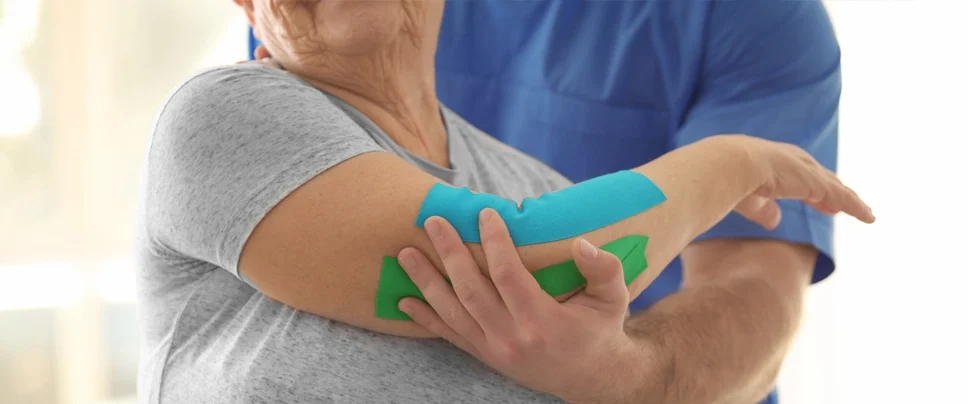
What is Osteoporosis?
Osteoporosis is a chronic, progressive condition which causes bones to lose their density. Cells called osteoclasts dissolve bone tissue, and other cells called osteoblasts fill in the holes that are left behind. In patients with osteoporosis, osteoblasts cannot keep up with the number of holes created by the osteoclasts, causing the bone to become porous.
In fact, broken down into its roots, osteoporosis comes from osteo, relating to the bones, and porosis, meaning porous. While normal bone marrow typically has minuscule holes left behind by the remodeling process, in patients with osteoporosis, these holes are much larger.
As a result, bones begin to lose density, becoming weaker and more fragile. Bones are more likely to break in the case of a fall, and in more serious cases, sneezing or minor bumps can even cause a fracture.
Risk Factors for Osteoporosis
Osteoporosis is classified as a bone disease that occurs when the body loses too much bone, makes too little bone, or both. This process can affect men and women of all races, and in the United States, more than 53 million people either already have osteoporosis or are at high-risk due to low bone mass.
However, white and Asian women are at a higher risk of developing osteoporosis. Older women who are past menopause are at the highest risk of developing osteoporosis. Risk factors for osteoporosis include:
- Age: The older you get, the greater the risk of osteoporosis.
- Sex: Women are much more likely to develop osteoporosis than men.
- Family History: A parent or sibling with osteoporosis puts you at greater risk.
- Low Calcium Intake: Low calcium intake causes diminished bone density over time.
- Sedentary Lifestyle: Spending more time sitting than being active can cause bone loss.
- Eating Disorders: Being severely underweight or restricting food intake weakens bones.
- Tobacco Use and Excess Alcohol Consumption: This lifestyle contributes to weak bones.
- Thyroid Problems: An overactive thyroid or thyroid hormone medication can cause bone loss.
- Certain Medical Conditions: Medical problems such as celiac disease, inflammatory bowel disease, cancer, lupus, and kidney or liver disease increase the likelihood of developing osteoporosis.
- Hormones: Reduction of estrogen in women and testosterone in men is one of the largest risk factors of osteoporosis. This is why post-menopause women are at the highest risk.
- Body Frame: Individuals with small body frames are at higher risk because they have less bone mass to draw from as they age.
- Medications and Steroids: Oral or injected corticosteroid medications interfere with the remodeling process.
Symptoms of Osteoporosis
There are typically no symptoms present in the early stages of bone loss. However, the development of low bone mass brings along the onset of osteopenia, a condition that prefaces full-fledged osteoporosis. As the bones begin to weaken throughout osteopenia and osteoporosis, patients begin to experience signs and symptoms such as:
- Loss of height over time
- Stooped or curved posture
- Back pain caused by a fractured or collapsed vertebra
- A bone fracture that occurs without severe trauma to the body
Those who have taken corticosteroids for several months at a time, or women who went through early menopause are more likely to develop these symptoms, as well as notice them earlier.
Chiropractic Treatment for Osteoporosis
Chiropractors are musculoskeletal experts by trade. This means that they are highly trained in all matters of the musculoskeletal system, which encompasses each and every bone, joint, muscle, tendon, and other soft tissue of the body. As musculoskeletal experts, chiropractic doctors make great strides in diagnosing and slowing the loss of bone density in patients with osteoporosis.
How a Chiropractor Diagnoses Osteoporosis
At your initial chiropractic appointment, a chiropractor will begin by performing a physical examination. Next, a chiropractor will determine a patient’s bone mineral density by requesting evaluation and testing. Bone density can be measured by a machine that uses low levels of x-rays to determine the proportion of mineral in bone. The test is completely painless, and consists of a patient lying on a padded table while a scanner passes over the body. In most cases, only key bones are checked: those in the hip, wrist, and spine.
The results of a bone density test are what informs a chiropractor of a patient’s current stage of osteoporosis, as well as what their likelihood is of breaking a bone within the next 10 years. Osteoporosis treatment recommendations are typically based on this estimated risk of fracture.
Osteoporosis Treatment and Bone Strengthening
Chiropractors provide drug-free and holistic treatment for osteoporosis. This means that a chiropractor will not prescribe harmful osteoporosis medications, which have known side effects including nausea, abdominal pain, fever, headaches, muscle aches, and heart-burn like symptoms.
Instead of injurious medications, chiropractors develop a personalized treatment plan which incorporates manual adjustments, spinal manipulations, and a variety of chiropractic treatments. Chiropractic osteoporosis treatment addresses the loss of bone mass with proven adjustments, and uses gentle techniques to also treat pain and discomfort in the soft tissue.
For instance, soothing treatments such as ultrasound and massage therapy are used to promote cellular growth and alleviate pain that can result from osteoporosis. Ultrasound therapy, a warming treatment applied directly to the skin above the affected area, is able to target and stimulate cellular growth to promote healing and reduce inflammation. Massage therapy soothes the soft tissue that can be affected by the postural or vertebral damage that osteoporosis can cause, relaxes muscles, and helps to decrease stress.
Are Chiropractic Adjustments Beneficial for Bone Loss?
Chiropractors provide effective and evidence-based treatment plans to maintain or regain bone strength necessary for optimal health. While many are familiar with the concept of chiropractic adjustments, many are unaware of the incredible benefits they have on bone itself.
Chiropractic adjustments benefit both joint motion and the central nervous system, helping to free any subluxations present in the body, and relieving pressure off nerve roots. In addition to relieving pain and inflammation, this process also benefits range of motion and overall energy. However, chiropractic adjustments also have an effect on the process of bone breakdown and replacement.
Chiropractic adjustments stimulate osteoblasts, the cells in charge of replacing bone. When a patient receives an adjustment, they’re not only improving their overall health, but they’re also giving their bone production a much-needed boost. Getting adjusted helps support the health of your bones and prevent osteoporosis, as well as help osteoblast production.
What Are the Risks of Osteoporosis Treatment?
Prior to receiving any type of osteoporosis treatment, it is pivotal for the physician at hand to evaluate both your medical history and symptoms to determine the fragility of your bones. Osteoporosis patients with very low bone density can fracture incredibly easily, meaning that a chiropractic physician should never rush straight into aggressive spinal manipulations.
At ChiroCare of Florida, our trusted physicians take the time to diagnose and assess the current fragility of bones prior to administering any type of treatment. Note that if you have active osteoporosis, certain adjustments may be modified until the strength of bones has improved. However, this does not exclude you from receiving adjustments or chiropractic care for osteoporosis.
It is also important to note that while osteoporosis can be treated, there is no type of treatment that can completely reverse the effects of osteoporosis. Osteoporosis treatment is meant to strengthen the bones, and with chiropractic, bone health and prevention can be achieved naturally and without the side effects of medication.
If you’re suffering advanced osteoporosis and have been given no choice but to be on medication, chiropractic is an excellent complementary therapy. Holistic and gentle, chiropractic therapy offers a plethora of benefits which can off-set the negative effects of medications.
Healthy Diet and Lifestyle Changes for Osteoporsis
In addition to receiving chiropractic adjustments, working with a chiropractor allows a patient a chance to implement a pivotal diet and lifestyle change. For osteoporosis patients, diet can greatly affect their rate of bone loss, as calcium levels are crucial to maintaining bone density.
Additionally, remaining active is also key to remaining healthy. While osteoporosis patients may want to avoid high impact activities which could increase their risk of fractures, exercise can help build strong bones and slow bone loss. Strength training combined with weight bearing and balance exercises are shown to reduce the negative impacts of osteoporosis.
A chiropractor can help implement healthy diet and lifestyle changes. To further slow the loss of bone mass, a patient should take the initiative to:
- Limit tobacco use and alcohol consumption
- Increase intake of calcium, including low-fat dairy and soy products
- Increase intake of protein, including nuts, legumes, or protein supplements
- Adhere to nutritional recommendations to maintain an appropriate body weight
- Partake in weight-bearing exercises, including walking, jogging, running, and dancing
Improved calcium and vitamin intake paired with a trusted fitness routine can help to maintain bone density. If you’ve been suffering from osteoporosis, or the negative side effects that accompany osteoporosis medication, it’s time to see a chiropractor.
With 11 offices throughout the South Florida area, ChiroCare of Florida is a full service chiropractic and wellness practice. Our dedicated chiropractors have over 50 years of combined experience, helping individuals of all walks of life. If your bones have begun becoming weak or brittle, don’t throw in the towel just yet. Contact ChiroCare of Florida to begin your osteoporosis treatment today.


